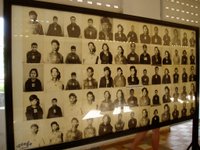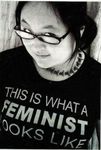
It was not hard to imagine that Cambodia has just experienced a traumatic and tragic period - where peace was only delivered less than 15 years ago. Victims of landmines fill the street, often dragging themselves in dust, uncomfortable wheel chairs, begging for just a little bit of money or food just to get by. Families are still grieving and looking for their loved ones lost 20 years ago, no traice, no sound, no bodies. Landmines still litter the country side, both those planted by the Khmer Rouge and the Americans - these weapons are blind - they don't just target enemy soldiers, but any one that steps on it - children, animals, bus load of people.
Being in the S21 (Security Prison 21) torcher chamber was really quite disconcerting. The rooms
 are empty except for a bed, bench or a few instruments used for torchering, to remind the visitors of the horrid emptiness of a victim''s existence - nothing but yourself, your pain, the sound of your own body being cut apart, and the laughter of the perpetrator. There were still splatters of blood on the ceiling that was not able to be scrubbed away. Being in here, in the rooms and walking the corridors makes the hair at the back of my neck stand up. This place glooms with death even after 30 years.
are empty except for a bed, bench or a few instruments used for torchering, to remind the visitors of the horrid emptiness of a victim''s existence - nothing but yourself, your pain, the sound of your own body being cut apart, and the laughter of the perpetrator. There were still splatters of blood on the ceiling that was not able to be scrubbed away. Being in here, in the rooms and walking the corridors makes the hair at the back of my neck stand up. This place glooms with death even after 30 years. Other rooms displayed the mugshots of the prisoners that were once detained in S21. Many of them are Khmer Rouge's own supporters. You can tell the high ranking ones by the clothes or scarves they wear. Some pictures are of dead bodies that have already been torchered to death. The KR take their pictures so that they can find their escaped families and persecute them later. I found it so disturbing that most of them looked much younger than I am. Pairs and pairs of eyes stairing at me, in dispair, disillusionment, hopelessness. There are other rooms that offered more sense of hope - artists that have experienced this create their own impressions of their pain, but also forgiveness and recovery. Those that have tried to move on from this dark past tells of their road back to peace and teaching their children about the past. In the last room there was a shelf displaying many skulls. A loop of paper cranes folded by Japanese students like the ones that I saw at the peace dome in Hiroshima hangs on the handles, wishing the Cambodians long lasting peace. I burst out crying when I saw this - why can't people learn from anything??? How could people do such things to each other when they have flesh and bloody themselves?
Other rooms displayed the mugshots of the prisoners that were once detained in S21. Many of them are Khmer Rouge's own supporters. You can tell the high ranking ones by the clothes or scarves they wear. Some pictures are of dead bodies that have already been torchered to death. The KR take their pictures so that they can find their escaped families and persecute them later. I found it so disturbing that most of them looked much younger than I am. Pairs and pairs of eyes stairing at me, in dispair, disillusionment, hopelessness. There are other rooms that offered more sense of hope - artists that have experienced this create their own impressions of their pain, but also forgiveness and recovery. Those that have tried to move on from this dark past tells of their road back to peace and teaching their children about the past. In the last room there was a shelf displaying many skulls. A loop of paper cranes folded by Japanese students like the ones that I saw at the peace dome in Hiroshima hangs on the handles, wishing the Cambodians long lasting peace. I burst out crying when I saw this - why can't people learn from anything??? How could people do such things to each other when they have flesh and bloody themselves?Its hard to imagine that this peaceful, quiet and tranquil space in the middle of PPN was a former death camp. The afternoon was sunny and the courtyard adorned by beautiful frangapania trees. Thirty years ago around here PPN was a dead city - the majority of the population evacuated to the country side - and banned from fleeing the country with the threat of huge lines of landmines around the Thai and Vietnamese boarders. No body would have heard the screams from s21 in the middle of the night. Except maybe the other prisoners and those that did the torchering - but I doubt that they'd hear if that is what you hear every minute of the waking hour. If hearing meant that you believe what you are hearing is the sound of another human being just like yourself.
 We traced the journey of a prisoner that would have been executed - after walking through the former torcher rooms and prison cells, down the stairs that the prisoners would have taken, we drove through leafy villages and to the Choeung Ek village, the so called "Killing Fields" where the remains of thousands of people have been recovered from mass graves - except we haven't been torchered and starved for weeks, we sat on an airconditioned bus and not bound to other bloodied prisoners on the back of a truck, we saw the day light and was not blind folded, and our lives was not so easily disrespected and disgarded.
We traced the journey of a prisoner that would have been executed - after walking through the former torcher rooms and prison cells, down the stairs that the prisoners would have taken, we drove through leafy villages and to the Choeung Ek village, the so called "Killing Fields" where the remains of thousands of people have been recovered from mass graves - except we haven't been torchered and starved for weeks, we sat on an airconditioned bus and not bound to other bloodied prisoners on the back of a truck, we saw the day light and was not blind folded, and our lives was not so easily disrespected and disgarded.Behind the shrine that was erected to remember the dead, there were hundreds of large holes in the ground, now grown over with grass, where plots of mass graves were found, and bones recovered - either returned to the victims'families if they were identified, or kept in the stupa with all the other bones. Victims were made to crouch down on the edge of the grave, beheaded or shot in the head and they would fall straight in. Plots carried up to 700 bodies at a time. There was one where most of the victims were women (often naked) and their babies. There was a tree beside that grave where the Khmer Rouge soldiers would bash the babies'heads against and throw straight into the grave. Our guide was almost trembling when she told us about this grave. But she says that after 14 years of coming here with people, she has put her fears behind her.
 The so called Killing Fields lie just 15 minutes outside of PPN - but in fact there were killing fields all over the country - mass graves were first discovered and recovered 10 year ago, but many of them out of the main centres are still being found. Now there are village children playing around the mounds. I wish that the children buried underneath could be doing the same. During the wet season the area gets flooded and after this bones still surface every year. Some bones is right next to the surface and you can see its outline on the dirt. Clothes that the victim wore are still half in the dirt and half out on the surface. There is a good number of plots that have been cleared out, but there are actually many many others behind the closed off area that the Cambodian gov hasn't got to - they think that these few are enough to remind the current generation of the mistakes of the previous, and because they do not want to disturb any more graves - or is it because they simply don't want to have to remember any more?
The so called Killing Fields lie just 15 minutes outside of PPN - but in fact there were killing fields all over the country - mass graves were first discovered and recovered 10 year ago, but many of them out of the main centres are still being found. Now there are village children playing around the mounds. I wish that the children buried underneath could be doing the same. During the wet season the area gets flooded and after this bones still surface every year. Some bones is right next to the surface and you can see its outline on the dirt. Clothes that the victim wore are still half in the dirt and half out on the surface. There is a good number of plots that have been cleared out, but there are actually many many others behind the closed off area that the Cambodian gov hasn't got to - they think that these few are enough to remind the current generation of the mistakes of the previous, and because they do not want to disturb any more graves - or is it because they simply don't want to have to remember any more?


2 comments:
i don't know if you remember but my parents sponsored several cambodian families while i was growing up. The Children's age when we meet ranged from newborn to 10 years old, but all them had been "on the run" their entire lives.
To live in nothing but war, known nothing but war, when war was supposed to be over.
I remember the parents would always grab our arms in amazement at how fat us kiwi kids were.
Immigration would *guess* the children's ages when they arrived - but they were often out by about 5 years. The parents lost track of time and their childrent's ages while fleeing for thier lives for over a decade.
The children were so malnourished, they might appear to be about 5 but their dentists would tell us they were more like 12 years old.
Being about 7 years old when these wonderful people came into my life, i just accepted it, as that was the world was. It wasn't until i was much older that i looked back and realised how little we comprehend of what those families went throught..
okay, enough, it's your blog i'll stop now
Lotsa love from Aotearoa
-B
Hey,
"Navigating and reading this terrific blog was not a waste of time... Thank You"
It is like a testimonial...LOL I hope you keep adding relative posts here so we will get more valuable info and enjoy ourselves too...
To you and your terrific blog :)
Thank You,
terrific blog
Post a Comment